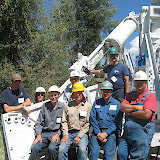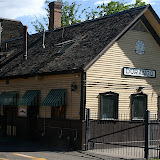
First let me say thanks to Terry, Sherii, Jeff, Bob, Mark, Bryant and G. O., I had a great time even if I was moving pretty slow.
Every summer, the
Friends of the Cumbres and Toltec host six volunteer sessions to work on various projects around the railroad. Projects range from baggage cart restoration to painting of buildings to complete rebuilds of rail cars. Or, in the case of the project I chose to volunteer for, the rebuild of a Jordon Spreader.
A
Jordon Spreader is a machine/contraption that, in various incarnations, dates back to at least the early 1900's. To many it is just a complicated snowplow but it was originally intended to be a ballast spreader and maintainer. The one we were working on was used primarily as a snowplow but, judging from the damage it has incurred, was probably used to push a little dirt around also.
In most all of it's models, the Jordan Spreader was an ungainly looking machine. It worked mostly by brute force, being shoved ahead of a locomotive and just pushing stuff out of the way with wings that traveled folded in but could be swung out and adjusted in height using air powered cylinders similar to train brake cylinders. There was usually a cab for the operator where he could move valves to operate the cylinders. The one we were working on still lacks it's new cab though many of the cab parts have been pre-constructed.
The work on the C&TSR Jourdan Spreader, designated OU, has been going on for 4 or 5 years now. The scope of the project has changed from a cosmetic restoration to a full mechanically operational rebuild that will allow the railroad to use it out on the line. Age and some severe damage have made this an ambitious project. The week I spent there involved installing back various parts that had been removed for repair or rebuild. We acomplished most of that with only some piping left to hook up. In addition, it was hoped to get the wooden deck attached and the operator cabin built. Because of the intricate fitting required to get the ship lap deck installed, only about a third of that was complete. Several parts of the operator cabin have been prefabricated but since the cabin requires the deck first, none of the cabin parts have been installed. It's possible another session will be scheduled in August of this year to finish up the leftover work.



















